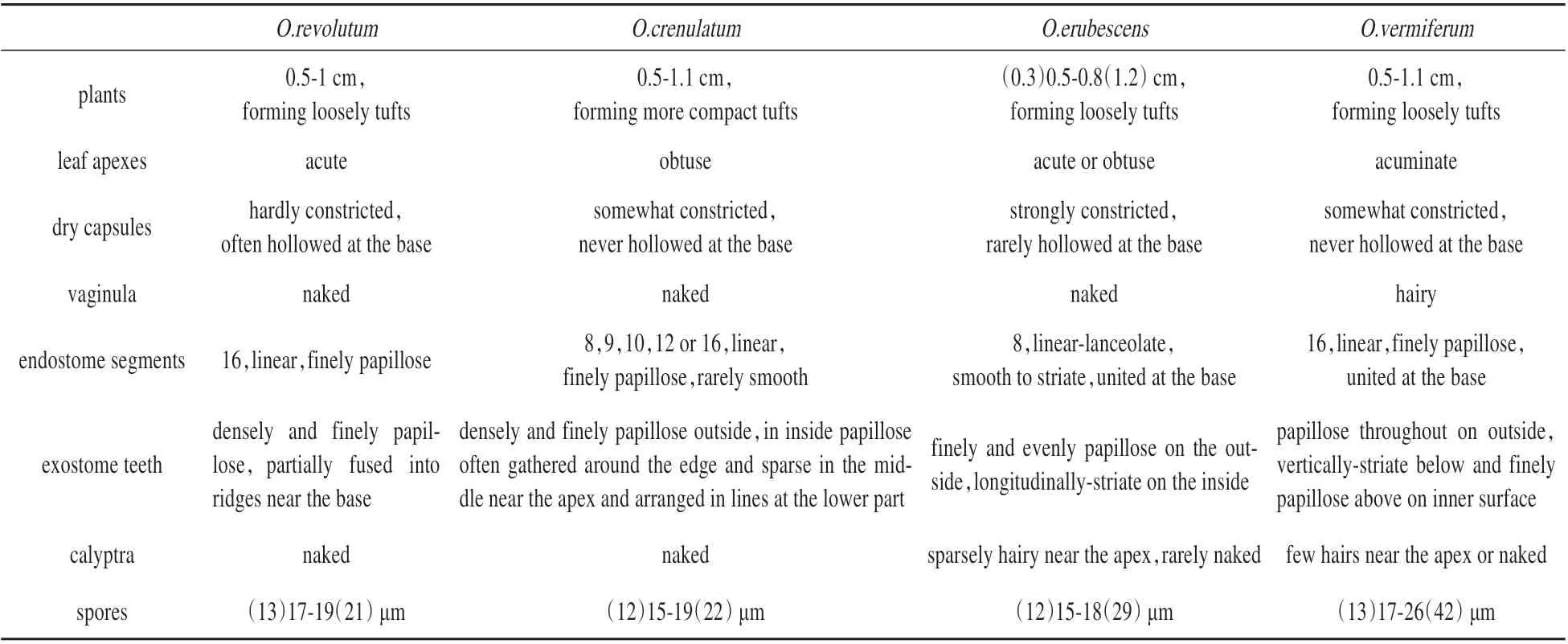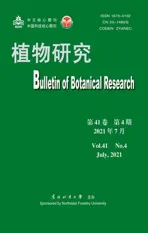Orthotrichum revolutum(Orthotrichaceae,Bryophyta),an Endemic Species to China,Rediscovered after 123 Years
2021-04-19WANGQingHuaHEQiangJIAYu
WANG Qing-Hua HE Qiang JIA Yu
(State Key Laboratory of Systematic and Evolutionary Botany,Institute of Botany,Chinese Academy of Sciences,Beijing 100093)
Abstract Orthotrichum revolutum,an endemic to China, has not been re-found since its original collection made 123 years ago. It is recorded from a new locality: Baihuashan Nature Reserve, Beijing, China. The plants morphologically agree well with the type specimens. Orthotrichum revolutum is firstly well photoed and its distribution is firstly mapped. Four records of this species from China’s Gansu, Xinjiang and Japan, Kyrgyzstan are all misidentifications in previous studies. We also discuss its main differences from close species and reevaluate its threat status in the field.
Key words mosses;taxonomy;Orthotrichum;Baihuashan;threat status
1 Introduction
A total of 40 species and two varieties of the ge⁃nus Orthotrichum Hedw. s.l.(vs. Orthotrichum s. str.in Plášek et al.[1])previously reported from China[2-5].Lewinsky[6]made a comprehensive revision of these species. Orthotrichum is widely distributed through⁃out China,especially in the west. Among them,14 are endemics,including Orthotrichum crispifolium Broth.,O.dasymitrium Lewinsky,O.erosum Lewin⁃sky,O.griffithii Mitt. ex Dixon,O.jetteae B.H. Al⁃len,O.laxum Lewinsky,O.leiolecythis Müll.Hal.,O.notabile Lewinsky,O.sinuosum,O.pulchrum Lewin⁃sky,O.revolutum Müll. Hal.,O.schofieldii(B.C. Tan& Y. Jia)B.H. Allen,O.subpumilum E.B. Bartram ex Lewinsky and O.vermiferum Lewinsky. Orthotri⁃chum revolutum is one of two oldest species(with O.erubescens)since its original description.
Orthotrichum revolutum was first described by Müller from Shaanxi Province of China in 1897[7],but no one have found it again in the field for almost 125 years. Although there have been few reports of this species,these are often checklists[8],or due to misidentification[3,9-10]. Lewinsky[6]in her revision of Orthotrichum in Southeast Asia,gave a detailed de⁃scription of O. revolutum based on type material.However,when we re-examine the type,we find that they only contain a small amount of material and the mature capsules are very few. Some characters within them are incomplete,such as exostome teeth and endostome segments,and others are poor,such as the surface ornamentation and size of spores. These characters are very important for the classification within Orthotrichum. Moreover,it is far not enough to recognize a species only from type specimens.Therefore,when we have been revising the Chinese Orthotrichum recently,the concept of O.revolutum is difficult to accurately understand and not easy to use in specimen identification.
Recently,we have collected a specimen of Or⁃thotrichum revolutum from a new locality,Bai⁃huashan Nature Reserve in Beijing. We therefore can make a more comprehensive and detailed description and comparison of the species,including morpholo⁃gy,habitat and geographical distribution,and finally confirm the concept of Orthotrichum revolutum.
2 Results
Orthotrichum revolutum Müll.Hal.
Nuovo Giorn. Bot. Ital.,n. s. 4:261. 1897.Type:CHINA. Prov. Schen-si sept.(=Shaanxi),in monte Lao-y-san(崂峪山),cum Orthotricho erubes⁃cente,Fabronia schensiana et Venturiella sinensi as⁃sociatum,Martio 1895,Giraldi 1509(lectotype FI012918! isolectotype H2996026!),Giraldi 1511(syntype FI012919!H2996026!).
Description:Plants green above,brown be⁃low,0.5–1 cm tall. Rhizoids present at stem base.Stems usually branched. Leaves erect,slightly flex⁃uose when dry,(1.5)1.9-2.5(3)mm long;leaf lami⁃na lanceolate,unistratose;apex acute;costa strong,ending shortly below the apex.Upper and middle lam⁃inal cells isodiametric,(4.6)8.7-12.8(16.8)×(6.1)9-11.7(15.2)µm,moderately thick-walled,with 1 or 2 low papillae per cell;basal laminal cells rectan⁃gular to quadrate,(14.5)29.5-48.5(71.6)×(6.5)10.6-14.2(19.1)µm,with thin walls,smooth.
Goniautoicous. Perichaetial leaves little longer than vegetative leaves,(1.5)1.7-2.8 mm long. Vagi⁃nula naked. Capsules immersed to 1/2 emergent,cy⁃lindrical,8 light furrows along the entire length,hardly constricted when dry and empty,1.5-1.7 mm long.Neck short,usually forming a hollow to hide the upper part of seta. Exothecial cells moderately differ⁃entiated into eight bands,yellowish,almost as long as urn,differentiated cells with thickened longitudi⁃nal walls. Stomata immersed,≥1/2 covered by sub⁃sidiary cells,in the central part of urn. Peristome double. Prostome not seen. Exostome teeth 16,usual⁃ly united into 8 pairs,lanceolate,densely and finely papillose,partially fused into ridges near the base,often reflexed when dry. Endostome segments 16,lin⁃ear,uniseriate,yellowish or hyaline,finely papil⁃lose. Opercula with a short beak. Calyptra conic,na⁃ked. Spores spherical,unicellular,finely papillose,(13)17-19(21)µm in diameter.
3 Discussion
Based on the type materials,Orthotrichum revo⁃lutum is distinguished by the erect or slightly flexu⁃ous,non-keeled leaves,emergent,furrowed but hard⁃ly constricted capsules that are hollow at the base,semi-immersed stomata,16 linear,papillose endo⁃stome segments,and naked calyptra(Fig.1).Our col⁃lection(Fig.2)agrees well with the type in morphology.
Due to only one revision in such long time,es⁃pecially the very inadequate type examination,Or⁃thotrichum revolutum is often misidentified in previ⁃ous studies. Recently,Orthotrichum revolutum was reported from Japan[10]and it was shown to have slightly emergent,ovate-oblong capsules gradually tapering into the seta,eight striate endostome seg⁃ments,naked calyptra and spores are 19–23 µm in diameter. However,Lewinsky[6]stated that Orthotri⁃chum revolutum had capsules that abruptly contract⁃ed to the seta,which causes a hollow at the capsule base. She also pointed out that there were 16 endo⁃stome segments with smooth or finely papillose,and spores are 12-18 µm in diameter. Type materials and our new specimen both confirm Lewinsky’s descrip⁃tion. Similarly,Orthotrichum revolutum from Kyrgyz⁃stan was described[11]as“the 16 erect endostome seg⁃ments are very conspicuous,and are as tall as theexostome teeth,and most of them have short lateral appendages.”However,endostome segments with ap⁃pendages do not agree with the type of Orthotrichum revolutum,and Lewinsky didn’t mention this feature in her revision[6]either. This collection thus is likely to be misidentified.Consequently,Orthotrichum revo⁃lutum is probably still restricted to China although we cannot make sure before we see the specimens.There are two other reports of Orthotrichum revolutum from Gansu and Xinjiang of China[3,9]. They are also misidentifications because of the obviously short ex⁃serted capsules in both and the markedly striate exo⁃stome teeth in the latter.

表1 O.revolutum,O.crenulatum,O.erubescens和O.vermiferum的主要形态差别Table 1 Main morphological differences in O.revolutum O.crenulatum O.erubescens and O.vermiferum
Capsules with a hollow at the base in Orthotri⁃chum revolutum are similar to those seen in O.erubes⁃cens. Additionally,these two species both have plane(not keeled)leaves,usually semi-immersed stoma⁃ta,frequently naked calyptra,and small spores. Or⁃thotrichum erubescens differs from O. revolutum by having strongly constricted capsules,obviously stri⁃ate exostome teeth,and eight endostome segments with a distinct basal membrane(Table 1).
Orthotrichum revolutum also resembles O. ver⁃miferum in emergent,furrowed but barely constrict⁃ed capsules,16 linear papillose endostome segments and semi-immersed stomata. The latter is distin⁃guished by keeled leaves,hairy vaginula,larger spores(17-26 µm)and capsules that are never hol⁃low at the base(Table 1).
Orthotrichum revolutum resembles O. crenula⁃tum due to its lanceolate,non-keeled leaves,16 lin⁃ear,papillose endostome segments,emergent cap⁃sules with eight barely constricted furrows,semi-im⁃mersed stomata,small spores,and naked calyptra.However,the latter differs by having more compact tufts,obtuse leaf apexes and exostome teeth with papillose often gathered around the edge and sparse in the middle near the apex(Table 1).
Key to Orthotrichum revolutum and its closely related species
1.Capsules strongly constricted when dry and empty;endostome segments smooth to striate ………………………… O.erubescens
1.Capsules somewhat or hardly constricted when dry and empty;endostome segments finely papillose,rarely smooth …………… 2
2.Vaginula hairy;spores larger,17-26µm………………………………………………………………………… O.vermiferum
2.Vaginula naked;spores small,15-19µm …………………………………………………………………………………… 3
3.Plants form loosely tufts;leaf apexes acute;capsules with a hollow at the base;exostome teeth densely and finely papillose,par⁃tially fused into ridges near the base ………………………………………………………………………………… O.revolutum
3.Plants form more compact tufts;leaf apexes often obtuse;capsules never hollowed at the base;exostome teeth with papillose of⁃ten gathered around the edge and sparse in the middle near the apex ……………………………………………… O.crenulatum
Orthotrichum revolutum was known only from one locality in Shaanxi and had not been re-found since Jos Giraldi collected it in 1895.A new locality,Baihuashan Nature Reserve of Beijing,was added in this study. The latitude of the new locality is much higher than that of the original one,it thus can be as⁃sumed that the main distribution of this species is likely to be restricted to northern China. Its habitat has not been recorded in detail before. According to our collection,it can grow at 1 326 meters above sea level and on trunk of Ulmus macrocarpa(Fig. 3).Type materials and our new collection both show that the population of Orthotrichum revolutum is very small and the number of mature individuals is about 10(Fig.3). At present,there are only two localities in China. According to the distribution area and the number of specimens,it is speculated that the popu⁃lation number is seriously reduced due to the extreme decline of habitat quality and the impact of human ac⁃tivities[2],its threat status is thus in critically endan⁃gered(A3c+3d). The previous assessment made by Qin et al.[12]is lower than us,because they consid⁃ered the distribution records of misidentification men⁃tioned above.
Specimens examined(all in PE):
O. revolutum:Beijing,Mentougou Distr.,Qin⁃gshui Town,Baihuashan national nature reserve,from management office to Baihuacaodian,Betula platyphylla-Quercus mongolica forest,alt. 1326 m,39.8327°N,115.5792°E,on trunk of Ulmus macro⁃carpa,21 May 2019,Jun-Jie Wang 1523.
O. crenulatum:Inner Mongolia:Helan Mt.,South Temple,Z.-G. Tong 2095-1. Xinjiang:Aksu City,Tomur Peak National Nature Reserve,M. Su⁃layman 11919,24304a,24316b;Altay City,Kanas Nature Reserve,M.Sulayman 140;Burqin Co.,He⁃mu,M. Sulayman 20101021-23;Fukang City,Tianchi,Q.-H. Wang 1371-2;Gongliu Co.,Tian Mt.,M. Sulayman 25104c;Miquan Co.,Haxiong⁃gou,J.-C.Zhao 8438,M.Sulayman 19362;Urumqi City,Nan Mt.,M. Sulayman 10-223;Xinyuan Co.,Tianshan Mt.,M. Sulayman 23301c;Yumin Co.,Baerluke Mt. Nature Reserve,M. Sulayman 2010-68a.
O. vermiferum:Gansu:Diebu Co.,Duoer for⁃est farm,M.-Z. Wang 54349-1;Wen Co.,Qiujia⁃ba,Y.Jia 09335f.Qinghai:Qiyuan Co.,Bangu tem⁃ple,J.-M. Liu 6787-1. Shaanxi:Qin Mt.,Huodi⁃gou,P.-C. Chen et al. 202c-6. Sichuan:Barkam City,P.-C. Wu 24311-4;Seda Co.,Y. Jia 02732d.Xizang:Jomda Co.,Tongpu,Y. Jia 07705-2;Zayü Co.,Cawarong,M.-Z.Wang 7889-b.
O. erubescens:Anhui:Huo Mt.,J.-Z. Xu 6.Chongqing:Nanchuan Co.,Mt. Jinfo Nature Re⁃serve,Y. Liu 2169b;Wushan Co.,Wulipo forest farm,Q.-H.Wang 968. Gansu:Wen Co.,Baishuiji⁃ang,M.-Z. Wang 63009e(2). Hunan:Sangzhi Co.,Badagongshan,T. Koponen,S. Huttunen,S. Piippo& P.-C. Rao 55725-1. Jiangxi:Lu Mt.,Huanglong Temple,Bryophyte class for further studies 39-2,X.-X.Zhong&X.-Z.Sun 32.Shannxi:Qinling Mt.,Z.-P.Wei 5266-4;Yang Co.,M.-Z.Wang 54941.Sich⁃uan:Jiuzhaigou Co.,Jiuzhaigou,P.-C.Wu 30043-2;Miyi Co.,M.-Z. Wang 20709;Wangcang Co.,Gu⁃cheng,Y. Jia 12104-2. Xizang:Yadong Co.,M.Zang 233. Yunnan:Dali City,Cang Mt.,C.-W.Wang 3316-1;Weixi Lisu Autonomous Co.,M.-Z.Wang 5128a.Zhejiang:Hangzhou City,Anon.5.
AcknowledgementsWe thank the curators at H and FI for their help during the visiting of the first au⁃thor.
